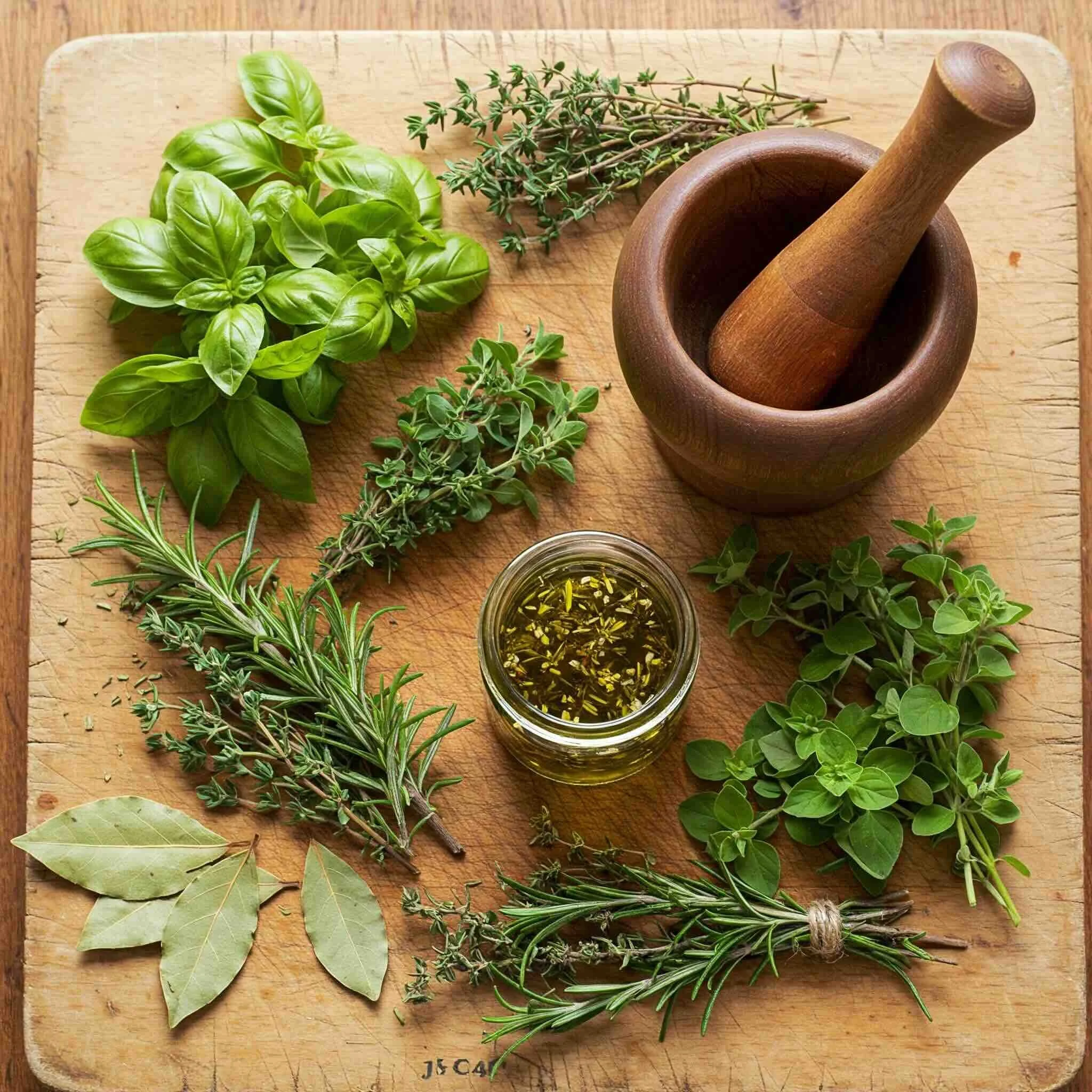Herb Alchemy – Mastering Fresh and Dried Herbs in Cooking
Herbs are one of the most powerful tools in plant-based cooking—they can transform simple ingredients into flavour-packed, aromatic, and deeply satisfying meals. Yet, many people underestimate the real impact of using herbs correctly.
Should you use fresh or dried? How do you pair herbs with plant-based ingredients? When should you add them to a dish? This guide will help you master herb alchemy so you can enhance every meal with confidence and creativity! 🚀
🔬 The Science of Herbs: How They Transform Flavour
Herbs don’t just add taste—they layer complexity into dishes. Their essential oils interact with heat, fat, and acidity, creating depth and balance in every bite.
✔️ Fresh vs. Dried Herbs – Key Differences
1️⃣ Fresh Herbs → Bright, delicate, aromatic; best for raw or lightly cooked dishes.
2️⃣ Dried Herbs → More concentrated and intense; best for slow-cooked or long-simmered meals.
🔥 Pro Tip: If substituting dried for fresh, use ⅓ of the amount, as dried herbs are more potent!
🌱 Fresh Herbs – When & How to Use Them
Fresh herbs provide vibrancy, freshness, and aroma, making them ideal for finishing dishes.
✔️ Best Uses for Fresh Herbs:
✔ Raw dishes – Salads, salsas, dressings, dips.
✔ Finishing cooked dishes – Sprinkle on pasta, soups, roasted veggies.
✔ Blended sauces – Pesto, chimichurri, herb-infused oils.
✔ Beverages & desserts – Mint in teas, basil with berries.
🔥 Pro Tip: Always add fresh herbs at the end of cooking to preserve their delicate flavours!
🍂 Dried Herbs – When & How to Use Them
Dried herbs are more intense and concentrated, making them ideal for dishes that need deeper, long-lasting flavour.
✔️ Best Uses for Dried Herbs:
✔ Slow-cooked meals – Soups, stews, curries, broths.
✔ Roasted & baked dishes – Root vegetables, tofu marinades.
✔ Dry rubs & spice blends – BBQ rubs, herb-crusted tofu.
✔ Infusions – Herb-infused oils, teas, vinegars.
🔥 Pro Tip: Add dried herbs at the start of cooking so they have time to release their full flavour!
🛠️ The Ultimate Herb Pairing Guide
Not all herbs work the same way! Here’s a breakdown of the best herb pairings for plant-based dishes:
🌿 Mild & Fresh Herbs (Great for salads, fresh dishes, and light cooking)
✔ Basil – Tomatoes, tofu, pasta, lemon.
✔ Mint – Peas, citrus, coconut milk, chocolate.
✔ Chives – Potatoes, tofu, avocado, creamy sauces.
✔ Cilantro – Lime, chilli, mango, black beans.
🌱 Earthy & Savoury Herbs (Great for slow-cooked meals, soups, and roasted dishes)
✔ Thyme – Mushrooms, lentils, roasted vegetables.
✔ Rosemary – Potatoes, tofu, olives, bread.
✔ Sage – Squash, mushrooms, brown butter flavours.
✔ Oregano – Tomato-based dishes, tofu marinades.
🔥 Bold & Aromatic Herbs (Great for strong, flavourful meals)
✔ Dill – Cucumber, yoghurt sauces, tofu scrambles.
✔ Tarragon – Mustard, lemon, creamy sauces.
✔ Bay Leaves – Soups, stews, lentil dishes.
✔ Marjoram – Pasta sauces, roasted tofu.
🔥 Pro Tip: Mix multiple herbs together for more depth—like basil + oregano for Italian flavours or thyme + rosemary for hearty dishes!
🛠️ Essential Herb Cooking Techniques
✅ Chopping Fresh Herbs: Use a sharp knife to prevent bruising and loss of essential oils.
✅ Releasing Dried Herb Flavour: Rub dried herbs between your fingers before adding them to a dish.
✅ Making Herb-Infused Oil: Blend fresh herbs with olive oil and store for drizzling over meals.
✅ Freezing Herbs: Chop fresh herbs, mix with a little oil, and freeze in ice cube trays for instant flavour boosts.
🔥 Pro Tip: For a quick flavour upgrade, stir minced fresh herbs into plant-based butter or hummus!
❌ Common Mistakes When Using Herbs
🚫 Adding fresh herbs too early → Their delicate flavour will cook off.
🚫 Using too many dried herbs → Overpowering and bitter if overused.
🚫 Storing herbs incorrectly → Fresh herbs wilt quickly if not stored properly.
🚫 Not balancing flavours → Bold herbs can dominate a dish if not paired thoughtfully.
🔥 Pro Tip: If a dish tastes flat, try adding a pinch of fresh herbs at the end—it can transform the flavour instantly!
🌟 Final Takeaway: Herbs Are a Game-Changer for Plant-Based Cooking
Herbs can take any plant-based meal from basic to extraordinary when used correctly.
✔ Use fresh herbs for brightness, dried for depth.
✔ Pair herbs with plant-based ingredients for balance.
✔ Store & handle herbs properly for maximum flavour.
✔ Experiment with different herb combinations for unique flavours.
Master these herb techniques, and your plant-based dishes will be bursting with flavour every time! 🚀🌿

